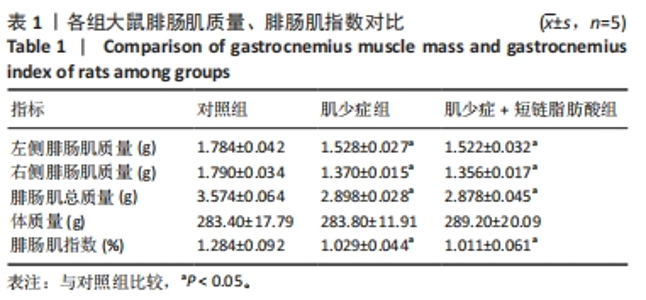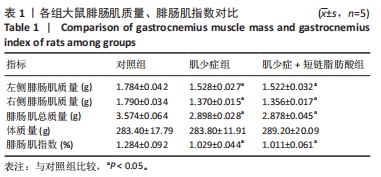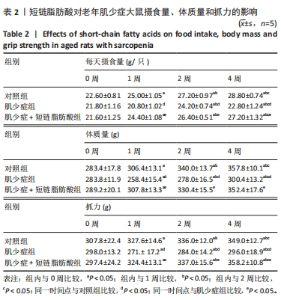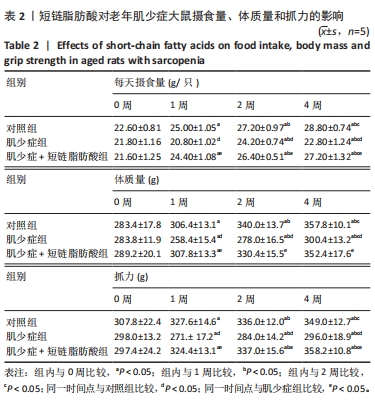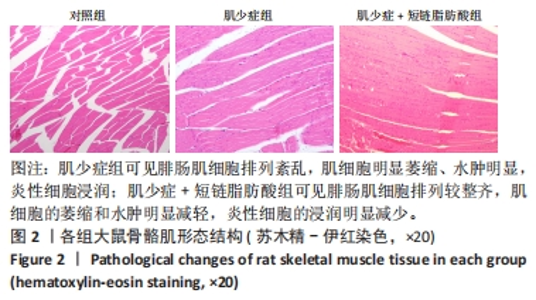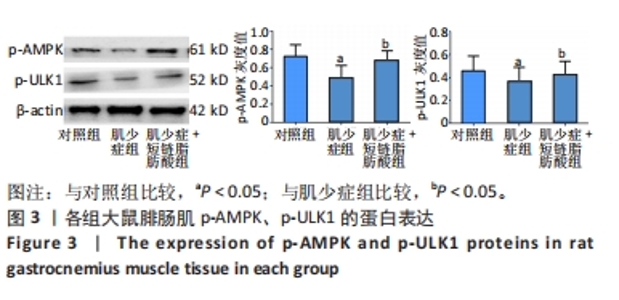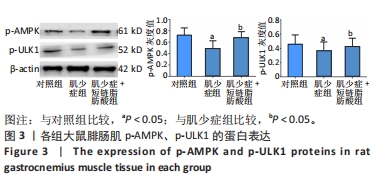[1] 刘盼,李耘,马丽娜.《初级保健机构中衰弱筛查和管理:国际衰弱和肌肉减少症研究会议工作组指南》解读[J].中国全科医学, 2021,24(25):3141-3147.
[2] FRAMPTON J, MURPHY KG, FROST G, et al. Short-chain fatty acids as potential regulators of skeletal muscle metabolism and function. Nat Metab. 2020;2(9):840-848.
[3] OTSUKA R, ZHANG S, FURUYA K, et al. Association between short-chain fatty acid intake and development of muscle strength loss among community-dwelling older Japanese adults. Exp Gerontol. 2023;173: 112080.
[4] RIOS-MORALES M, VIEIRA-LARA MA, HOMAN E, et al. Butyrate oxidation attenuates the butyrate-induced improvement of insulin sensitivity in myotubes. Biochim Biophys Acta Mol Basis Dis. 2022; 1868(11):166476.
[5] IKEDA T, NISHIDA A, YAMANO M, et al. Short-chain fatty acid receptors and gut microbiota as therapeutic targets in metabolic, immune, and neurological diseases. Pharmacol Ther. 2022;239:108273.
[6] SALVI PS, COWLES RA. Butyrate and the Intestinal Epithelium: Modulation of Proliferation and Inflammation in Homeostasis and Disease. Cells.2021;10(7):1775.
[7] ALI I, LI C, KUANG M, et al. Nrf2 Activation and NF-Kb & caspase/bax signaling inhibition by sodium butyrate alleviates LPS-induced cell injury in bovine mammary epithelial cells. Mol Immunol. 2022;148:54-67.
[8] HU Q, CUI H, MA C, et al. Lipidomic metabolism associated with acetic acid priming-induced salt tolerance in Carex rigescens. Plant Physiol Biochem. 2021;167:665-677.
[9] ZHAO ZH, WANG ZX, ZHOU D, et al. Sodium Butyrate Supplementation Inhibits Hepatic Steatosis by Stimulating Liver Kinase B1 and Insulin-Induced Gene. Cell Mol Gastroenterol Hepatol. 2021;12(3):857-871.
[10] CHENG L, SHI L, HE C, et al. Rutin-activated adipose tissue thermogenesis is correlated with increased intestinal short-chain fatty acid levels. Phytother Res. 2022;36(6):2495-2510.
[11] 李聪,高泽林,方碧青,等.肌少症动物模型的研究进展[J].中国实验动物学报,2021,29(1):85-90.
[12] EDSTROM E, ULFHAKE B. Sarcopenia is not due to lack of regenerative drive in senescent skeletal muscle. Aging Cell. 2005;4(2):65-77.
[13] 向小琴, 张婷婷, 钟江姗,等. 短链脂肪酸对脂多糖诱导的大鼠急性呼吸窘迫综合征的影响及其作用机制[J]. 解放军医学杂志,2022, 47(6):561-568.
[14] TOMCZYK-WARUNEK A, DUBIEL A, POLESZAK E, et al. Disorders of the intestinal flora and it is effect on skeletal system diseases. Wiad Lek. 2020;73(9 cz. 1):1835-1839.
[15] PROKOPIDIS K, CHAMBERS E, NI LOCHLAINN M, et al. Mechanisms Linking the Gut-Muscle Axis With Muscle Protein Metabolism and Anabolic Resistance: Implications for Older Adults at Risk of Sarcopenia. Front Physiol. 2021;12:770455.
[16] LAHIRI S, KIM H, GARCIA-PEREZ I, et al. The gut microbiota influences skeletal muscle mass and function in mice. Sci Transl Med. 2019; 11(502):eaan5662.
[17] 吕晓婷, 洪宇桁, 牛文彦. 短链脂肪酸对C2C12小鼠骨骼肌细胞AMPK的作用研究[J].天津医科大学学报,2019,25(1):1-4.
[18] CHEN F, LI Q, CHEN Y, et al. Association of the gut microbiota and fecal short-chain fatty acids with skeletal muscle mass and strength in children. FASEB J. 2022;36(1):e22109.
[19] LV WQ, LIN X, SHEN H, et al. Human gut microbiome impacts skeletal muscle mass via gut microbial synthesis of the short-chain fatty acid butyrate among healthy menopausal women. J Cachexia Sarcopenia Muscle. 2021;12(6):1860-1870.
[20] CHEN GQ, GONG RH, YANG DJ, et al. Halofuginone dually regulates autophagic flux through nutrient-sensing pathways in colorectal cancer. Cell Death Dis. 2017;8(5):e2789.
[21] WANG W, JIANG J, HUANG Y, et al. Aconitine induces autophagy via activating oxidative DNA damage-mediated AMPK/ULK1 signaling pathway in H9c2 cells. J Ethnopharmacol. 2022;282:114631.
[22] ZENG Z, LIANG J, WU L, et al. Exercise-Induced Autophagy Suppresses Sarcopenia Through Akt/mTOR and Akt/FoxO3a Signal Pathways and AMPK-Mediated Mitochondrial Quality Control. Front Physiol. 2020; 11:583478.
[23] WIEDMER P, JUNG T, CASTRO JP, et al. Sarcopenia - Molecular mechanisms and open questions. Ageing Res Rev. 2021;65:101200.
[24] JIAO J, DEMONTIS F. Skeletal muscle autophagy and its role in sarcopenia and organismal aging. Curr Opin Pharmacol. 2017;34:1-6.
[25] 邓邦利. 钙信号和短链脂肪酸调节糖代谢机制研究[D].天津:天津医科大学,2018.
[26] 张春雪,王晨菲,靳瑾.短链脂肪酸通过激活GPR43上调AMPK信号通路抑制小鼠胰岛β细胞凋亡[J].国际检验医学杂志,2023,44(9): 1110-1115+1120.
[27] GIHA HA, ALAMIN O, SATER MS.Diabetic sarcopenia: metabolic and molecular appraisal. Acta Diabetol. 2022;59(8):989-1000.
[28] TAN Y, LIU X, YANG Y, et al. Metabolomics analysis reveals serum biomarkers in patients with diabetic sarcopenia. Front Endocrinol (Lausanne). 2023;14:1119782.
[29] KALINKOVICH A, LIVSHITS G. Sarcopenic obesity or obese sarcopenia: A cross talk between age-associated adipose tissue and skeletal muscle inflammation as a main mechanism of the pathogenesis. Ageing Res Rev. 2017;35:200-221.
[30] DEN BESTEN G, BLEEKER A, GERDING A, et al. Short-Chain Fatty Acids Protect Against High-Fat Diet-Induced Obesity via a PPARγ-Dependent Switch From Lipogenesis to Fat Oxidation. Diabetes. 2015;64(7):2398-2408.
|
